 |
PROTECTING THE LIBRARIES' TREASURES
BY MEREDITH GOZO |
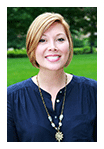 In the fall of 2015, as a part of the rightsizing efforts, I began a project to investigate what materials might be in the closing libraries that required consideration for transfer to archives and special collections. It has been a venture that falls perfectly at the intersection of the two things that matter to me the most: rare books and cataloging. In the fall of 2015, as a part of the rightsizing efforts, I began a project to investigate what materials might be in the closing libraries that required consideration for transfer to archives and special collections. It has been a venture that falls perfectly at the intersection of the two things that matter to me the most: rare books and cataloging.
As a start, Sammie Morris, University Archivist and Head of Archives and Special Collections, and I sat down with the library’s policy on transfer of materials and used it to pin down what characteristics to look for among the materials in the circulating collections. This policy, based on the ACRL Guidelines on the Selection and Transfer of Materials from General Collections to Special Collections, notes age, condition, market or research value and specific bibliographic characteristics as significant cause to shift materials into more secure conditions. There are a great number of characteristics that might make a book a candidate for special collections. Some listed in our policy include:
- Fine bindings (particularly covers of vellum or animal skin, hand tooled leather, or other early or unusual decorative bindings)
- Books with significant provenance (owned or associated with a noteworthy person or event, particularly if they contain ownership marks or a bookplate of the person)
- Extra-illustrated volumes, such as rare fine arts books with numerous plates
- Items made out of unusual materials, such as metal, wood, vellum, handmade paper, etc.
- Custom-produced and/or handmade books
- Scarcity
Naturally, items related to Purdue and to local history are also significant, as well as books published in Indiana or by Indiana authors.
The next step in the project was to gather the materials from the libraries, which happened via a two-pronged process of data collection and physical labor: using Alma, I constructed and ran searches on the library’s bibliographic data to compile reports of likely candidates for ASC. Library by library, I put together lists of materials that needed retrieval or review. Using 1880 as the terminal date for my searches, I looked at age, publication location, subject matter and other data pulled from the bib records to get information on the materials out in the libraries. I looked at OCLC holdings to check item scarcity and made as many determinations as I could with the data. But in most cases, it was important to look at the books themselves: the records for general collections materials do not contain the kind of information that might have made retrieval of fine bindings, provenance information, small press runs, or other unique qualities readily apparent: that kind of cataloging is done when an item goes into special collections.
Therefore, for the better part of two years, I have spent my time going out to the closing libraries to review, pull, and box materials to shift them to special collections. Moreover, I spent a great deal of time sifting through the books in the library’s repository spaces, where materials have been greatly consolidated in preparation for the transfer of the six closing libraries’ general collections. I could never have done all this work without having Samantha Brown, a student in Metadata Services, assist me with the project. I trained Sam in rare book handling and in fundamentals of descriptive bibliography, and she worked side-by-side with me (as well as alone when meetings and other duties pulled me in other directions) to collect everything we could find that was on our spreadsheets. We spent mind-numbing hours on collection of holdings info from OCLC and in review of materials on spreadsheets or in-hand. Sam was a real trooper. I think for the both of us there was thrill in the hunt, and there was repeated satisfaction as we went forth and found so much great material everywhere.
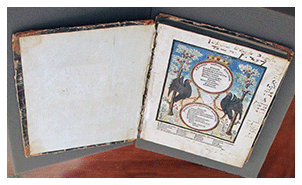 To date, more than 5,500 titles have been shifted from general to special collections holdings. We found an incunable, a small collection of Nazi agricultural publications, an exceptional collection of foreign-language cookbooks, and a few hundred books pre-dating 1800, made in the hand-press period on laid paper and in historical bindings. The great wealth of Purdue’s collections, however, are from the 19th century, when industrial processes made both the books themselves and the advancements contained in them possibilities. It struck me, when paging through some of these books, that they contained the ideas and notions that nurtured the minds of Purdue’s earliest students. Many of these books are worn and tattered from use — not what you’d think would go into the library’s archives — but their significance to the university’s history give them great value. To date, more than 5,500 titles have been shifted from general to special collections holdings. We found an incunable, a small collection of Nazi agricultural publications, an exceptional collection of foreign-language cookbooks, and a few hundred books pre-dating 1800, made in the hand-press period on laid paper and in historical bindings. The great wealth of Purdue’s collections, however, are from the 19th century, when industrial processes made both the books themselves and the advancements contained in them possibilities. It struck me, when paging through some of these books, that they contained the ideas and notions that nurtured the minds of Purdue’s earliest students. Many of these books are worn and tattered from use — not what you’d think would go into the library’s archives — but their significance to the university’s history give them great value.
There are still loose ends to tie up on the project: little pockets of collections I have not yet been able to visit, materials people sent to my office that are in boxes or piles for review. In the end, I will compile data on all the books we didn’t manage to find, so if you are thinking at this very moment of a book on a shelf that you have eyed many times and thought it might be of value, shoot me an email: we might have been looking for it and passed it over.
I want to take the opportunity to express my thanks to the many extraordinary people who have assisted me in small and big ways on this project over the past two years: Sammie Morris for consulting with me on details, Gene Ann Fausett and Joe Kinzig for their generous time and efforts to assist me in finding triage spaces for all the materials, the staff in HKRP who have helped me with innumerable requests, and Facilities staff who always had the great pleasure of retrieving the trail of boxes I left behind me everywhere. I’d also like to thank Rebecca Richardson and the staff in Metadata Services who understood and supported the work I did on this project in lieu of my other responsibilities. Descriptive cataloging of the books will begin shortly to start putting the kinds of information in the records that is useful to researchers looking for them. I can’t wait for these materials to be made available in the ASC reading room, where they can be used and cared for in a manner consistent with their exceptional cultural, aesthetic, or intellectual value. Make sure to take some time to visit them in their new home once they are available. |
 |
PURDUE LIBRARIES SELECTED AS 2017-18 SITE FOR PROJECT INFORMATION LITERACY VISITING SCHOLAR PROGRAM
|
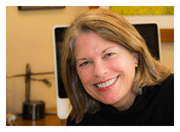 Purdue University Libraries has been selected as the academic library system to host Project Information Literacy’s new Visiting Research Scholar program during the 2017-18 academic year. Purdue University Libraries has been selected as the academic library system to host Project Information Literacy’s new Visiting Research Scholar program during the 2017-18 academic year.
The Project Information Literacy (PIL) program will provide Purdue Libraries faculty researchers with access to a research consultant in the form of expert information literacy researcher Alison Head, the founder and executive director of PIL. Throughout the academic year, Head, who is also a senior researcher at the metaLAB at Harvard, will mentor Purdue Libraries researchers on their scholarly research projects, both large and small, through the PIL’s Visiting Research Scholar program.
“We are thrilled Purdue Libraries has been selected as the 2017-18 home of Project Information Literacy’s Visiting Research Scholar program,” noted Libraries Dean James L. Mullins. “The PIL program will give our faculty members a unique opportunity to work with a pre-eminent leader in information literacy research, and we anticipate the PIL program will further develop their research skills. We look forward to working with Dr. Head in her mentoring role this coming year in the Libraries,” he added.
As the selected library organization for the Visiting Research Scholar program this academic year, Purdue Libraries will benefit from having access to two research methods webinars, as well as 15-20 one-on-one research consultations, via video, with Purdue Libraries researchers conducted by Head. She will also travel to Purdue University and deliver a campus-wide keynote presentation during her on-site visit as part of the program.
“Purdue Libraries has a vibrant community of information literacy researchers working on a range of groundbreaking research projects. That’s why I selected Purdue Libraries as the host institution this year. In addition, information literacy is clearly a top priority for the entire Purdue University campus,” she said.
About PIL and the Visiting Research Scholar Program
According to Head, the PIL Visiting Research Scholar program began with a pilot phase in 2016-17 at the University of Nebraska Library.
“The program’s sole purpose has been for PIL to provide a year of research consultations, so that librarians may become more qualified and improved information literacy researchers,” Head explained.
Since 2008, Head and her team of PIL researchers have interviewed and surveyed over 13,000 undergraduates at more than 60 U.S. four-year public and private universities and colleges and two-year community colleges. PIL has published nine open-access research reports as part of the ongoing study.
In a 2016 Inside Higher Education column, Barbara Fister called PIL: “hands-down the most important long-term, multi-institutional research project ever launched on how students use information for school and beyond.”
Articles about PIL’s work have also appeared in The Atlantic Magazine, The Huffington Post, The Chronicle of Higher Education, Education Week, Inside Higher Education, Library Journal, and The Seattle Times.
Head also led the 2007 exploratory information literacy study, a forerunner to PIL, at Saint Mary’s College of California, where she taught as the Disney Visiting Professor in New Media for 10 years.
Head earned her Ph.D. in information science, as well as her MLS and BA degrees, from U.C. Berkeley. She was awarded the inaugural S. T. Lee Lectureship in Library Leadership and Innovation at Harvard Library for 2017-19. In addition, she has been a Research Fellow and a Faculty Associate at Harvard University’s Berkman Klein Center for Internet & Society, as well as a Visiting Scholar at Stanford University, where she studied human-computer interaction.
Learn more about PIL at www.projectinfolit.org. |
 |
LCSSAC UPDATE
BY LIZ LUKENS |
I would like to take this opportunity to let everyone know what the Libraries Clerical Service Staff Advisory Committee (LCSSAC) is all about and what activities we sponsor.
This committee is comprised of six members from the clerical and service staff of the Libraries. We bring suggestions and concerns to the Libraries administration.
The current members are:
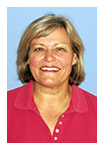 District A - HSSE, HICKS, PARRISH District A - HSSE, HICKS, PARRISH
Leslie Matteson
lnmattes@purdue.edu
Parrish Library
|
 District B - AVTE, MATH, VETM, WALC District B - AVTE, MATH, VETM, WALC
Liz Lukens - Chair
eelukens@purdue.edu
WALC
|
 District C - ACQ, ADMN, BUS, COPY, COLLECTIONS & ACCESS, PLF District C - ACQ, ADMN, BUS, COPY, COLLECTIONS & ACCESS, PLF
Jacinda Laymon - Secretary
jlaymon@purdue.edu
PLF
|
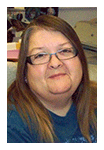 At Large At Large
Angie Ewing
aewing@purdue.edu
Math |
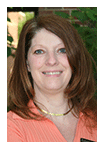 At Large At Large
Sandy Galloway - Vice Chair
sgallow@purdue.edu
WALC |
 At Large At Large
April Maybee
amaybee@purdue.edu
Collections & Access - Acquisitions |
Here is a list of a few things we do on this committee:
- The LINK Letter offers the Libraries' clerical and service staff the opportunity to anonymously ask questions, voice concerns, or offer suggestions regarding employment conditions in the Libraries.
- Breakfast with the Deans is a chance to talk to the Deans face-to-face about any concerns you might have related to the Libraries.
- One Book Higher Poster – Poster to highlight the different activities and accomplishments of the Committee.
- Picnic – A great way to get to know different people of the Purdue Libraries, along with their families, while enjoying great food and, of course, trying to complete the crossword puzzle!
We urge everyone who is Libraries Clerical and Service Staff to consider becoming a part of this committee when elections are held for their district. This is a great way to serve the other Clerical and Service Staff members in the Libraries!
LCSSAC is the “voice” of the clerical and service staff of the libraries. |
 |
FROM THE PAST TO THE FUTURE – PHYSICS LIBRARY
BY TERESA BROWN |
"To build up the future, you have to know the past." — Otto Frank
This is the sixth and final entry about the six Purdue University Libraries that have been relocated into the Thomas S. and Harvey D. Wilmeth Active Learning Center (WALC).
A LOOK BACK AT THE PHYSICS LIBRARY
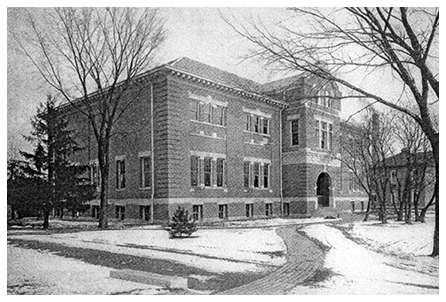 Physics has always been at Purdue University, since the university first opened its doors on September 16, 1874, but it was always associated with an engineering program until the establishment of an independent Department of Physics in 1904. Physics has always been at Purdue University, since the university first opened its doors on September 16, 1874, but it was always associated with an engineering program until the establishment of an independent Department of Physics in 1904.
The first Physics building opened in January 1905 in what was the Biology Annex, later named Stanley Coulter Annex and now the current location of the Class of 1950 Lecture Hall.
In 1928, the Physics Library consisted of one corner of a very small room that had a few shelves of text books for general physics. The room was under the supervision of a member from the Physics department. The collection was closed to students except on application to the faculty member in charge. Staff were told if they wanted to do research work, they would have to do it at their own expense and on their own time.
In 1929, 810 bound journals and 465 books were moved from the General Library to the Physics Library. Karl “Doc” Lark-Horovitz from the Physics department organized and expanded the library space into a physics research space. They also canvased all of the individual sections of Physics for books from the reading rooms in High Energy, Solid State, Theoretical Physics and Astronomy to fill the library. More transfers from the General Library and a completed card catalog for its holdings were completed in 1930. The library remained under the direction of the Physics department until 1934 when Purdue President Edward Elliott (1922-1945) moved it under the direction of the Library, during William Hepburn’s reign as Director of the Libraries (1904-1944).
A new Physics building was built in 1941 at the corner of Northwestern Avenue and University Street and the library was opened in the new building, room 254, in 1944-45. In 1966, there were 19,600 volumes and Harry Kuntz was the librarian.
In 1969, a new addition to the Physics building was completed and the library was moved into its current location in 1970 room 290.
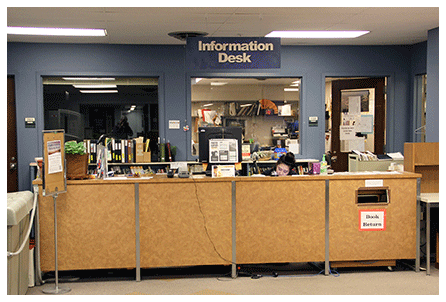 Improvements over the years included painting and furniture additions from other libraries. In 1999, the library received a face lift that included rearranging the abstract and reference sections to provide study alcoves for small group usage and relocation of the public terminals (Inside Scoop, December 1, 1999). In 2009, the book collection was moved from the second floor to the first floor, to make it easier for staff to help locate books and for faculty to get to the books more quickly. Journals were relocated to the second floor (INSIDe 8/13/2009). In 2012, a revamping of the library space took place including a reference update project and merging the current journals with the new books to make space for a collaborative learning area complete with whiteboards, moveable furniture and a projector (INSIDe, October 31, 2012). Improvements over the years included painting and furniture additions from other libraries. In 1999, the library received a face lift that included rearranging the abstract and reference sections to provide study alcoves for small group usage and relocation of the public terminals (Inside Scoop, December 1, 1999). In 2009, the book collection was moved from the second floor to the first floor, to make it easier for staff to help locate books and for faculty to get to the books more quickly. Journals were relocated to the second floor (INSIDe 8/13/2009). In 2012, a revamping of the library space took place including a reference update project and merging the current journals with the new books to make space for a collaborative learning area complete with whiteboards, moveable furniture and a projector (INSIDe, October 31, 2012).
Lil Conarroe, library assistant, has worked in the Physics Library for 38 years. She notes that she was hired by Martha Bailey on May 21, 1979 before Martha was appointed Life Sciences librarian. Richard Funkhouser served as interim librarian each time a change in leadership was made. Previous Physics librarians that Lil worked for included Dennis Parks, Scott Brandt, Janet Hutner, Ann Kerker, Pat Allen, Carolyn Laffoon, and currently, Nastasha Johnson.
 An interesting story that has been retold to Lil was when Physics was asked for space for a library they agreed but assumed it would be “Physics Library” not “Library in Physics.” The difference being, they hired the librarian without consulting the Library director. An interesting story that has been retold to Lil was when Physics was asked for space for a library they agreed but assumed it would be “Physics Library” not “Library in Physics.” The difference being, they hired the librarian without consulting the Library director.
“I have always felt a part of the location and several professors and secretaries have stopped by the library asking for my office and personal phone numbers so they can keep in touch. Their biggest concerns seems to be where they will send their students to take tests,” said Lil.
Scott Brandt served as head of Physics (and Earth and Planetary Sciences, i.e., “PEAS”) from 1986-1989. He inherited an acquisitions program that Dennis Parks had written using Unix scripts on the department’s VAX 11/780 computer. Scott added some descriptive fields to turn it into one of the Libraries’ early online catalogs. The Physics Library was also home of the first email account (on said VAX). A year earlier, while working in Math, Scott asked for an email account at PUCC and was told, “We consider email to be this far [thumb and finger half an inch apart] above games. No!” But when he asked Professor Fuchs, a heavy computer user in physics, the reply was, “Absolutely! 80% of what I do is communication.” And because the VAX was connected to the Internet, the Physics Library was an early user of electronic document delivery, accessing the physics preprint archive at the Stanford Linear Accelerator Center—it took up to 30 minutes to access and print a paper. Sources
A Century of Science, Department of Physics 1904-2004, Purdue University
A Brief History of the Purdue University Libraries, 1874-1971, by William M. Hepburn |
 |
JULY SMILE AWARD
|
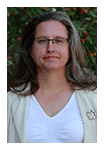 Victoria Thomas’ name was randomly drawn from all those who were SMILED upon in July. She received a $25 Von’s Book Shop gift certificate. Victoria Thomas’ name was randomly drawn from all those who were SMILED upon in July. She received a $25 Von’s Book Shop gift certificate.
All faculty, administration and staff are invited to send a note of appreciation for a kindness or thoughtfulness given, assistance provided to or by a Libraries, Press or Copyright Office colleague.
To learn more about how to participate in our SMILE Program, please visit and bookmark this page on the Libraries intranet: http://intranet.lib.purdue.edu/display/HR/SMILE+Program/ |
 |
AROUND THE LIBRARIES
|
HSSEB Summer Tours
HSSEB staff recently visited the Technology Resource Center (TRC) in Beering Hall of Liberal Arts and Education to view their resources available for education students. It was amazing what they had to offer in regards to equipment rental, books, and printing materials.
The staff also toured the beautiful Black Cultural Center (BCC) led by Renee Thomas, director. The BCC has many amazing pieces of art that everyone should see, an ITaP lab, meeting spaces and book collection.
The HSSEB staff will be sure to let students know about both of these facilities and their unique offerings!
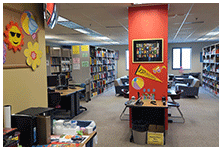 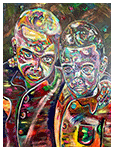 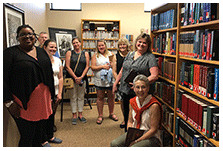
Photos by Leslie Matteson, Beth Moore and Lisa Carter |
|
|
|

 In the fall of 2015, as a part of the rightsizing efforts, I began a project to investigate what materials might be in the closing libraries that required consideration for transfer to archives and special collections. It has been a venture that falls perfectly at the intersection of the two things that matter to me the most: rare books and cataloging.
In the fall of 2015, as a part of the rightsizing efforts, I began a project to investigate what materials might be in the closing libraries that required consideration for transfer to archives and special collections. It has been a venture that falls perfectly at the intersection of the two things that matter to me the most: rare books and cataloging.  To date, more than 5,500 titles have been shifted from general to special collections holdings. We found an incunable, a small collection of Nazi agricultural publications, an exceptional collection of foreign-language cookbooks, and a few hundred books pre-dating 1800, made in the hand-press period on laid paper and in historical bindings. The great wealth of Purdue’s collections, however, are from the 19th century, when industrial processes made both the books themselves and the advancements contained in them possibilities. It struck me, when paging through some of these books, that they contained the ideas and notions that nurtured the minds of Purdue’s earliest students. Many of these books are worn and tattered from use — not what you’d think would go into the library’s archives — but their significance to the university’s history give them great value.
To date, more than 5,500 titles have been shifted from general to special collections holdings. We found an incunable, a small collection of Nazi agricultural publications, an exceptional collection of foreign-language cookbooks, and a few hundred books pre-dating 1800, made in the hand-press period on laid paper and in historical bindings. The great wealth of Purdue’s collections, however, are from the 19th century, when industrial processes made both the books themselves and the advancements contained in them possibilities. It struck me, when paging through some of these books, that they contained the ideas and notions that nurtured the minds of Purdue’s earliest students. Many of these books are worn and tattered from use — not what you’d think would go into the library’s archives — but their significance to the university’s history give them great value.  Purdue University Libraries has been selected as the academic library system to host Project Information Literacy’s new
Purdue University Libraries has been selected as the academic library system to host Project Information Literacy’s new  District A - HSSE, HICKS, PARRISH
District A - HSSE, HICKS, PARRISH District B - AVTE, MATH, VETM, WALC
District B - AVTE, MATH, VETM, WALC District C - ACQ, ADMN, BUS, COPY, COLLECTIONS & ACCESS, PLF
District C - ACQ, ADMN, BUS, COPY, COLLECTIONS & ACCESS, PLF At Large
At Large At Large
At Large At Large
At Large Physics has always been at Purdue University, since the university first opened its doors on September 16, 1874, but it was always associated with an engineering program until the establishment of an independent Department of Physics in 1904.
Physics has always been at Purdue University, since the university first opened its doors on September 16, 1874, but it was always associated with an engineering program until the establishment of an independent Department of Physics in 1904. Improvements over the years included painting and furniture additions from other libraries. In 1999, the library received a face lift that included rearranging the abstract and reference sections to provide study alcoves for small group usage and relocation of the public terminals (Inside Scoop, December 1, 1999). In 2009, the book collection was moved from the second floor to the first floor, to make it easier for staff to help locate books and for faculty to get to the books more quickly. Journals were relocated to the second floor (INSIDe 8/13/2009). In 2012, a revamping of the library space took place including a reference update project and merging the current journals with the new books to make space for a collaborative learning area complete with whiteboards, moveable furniture and a projector (INSIDe, October 31, 2012).
Improvements over the years included painting and furniture additions from other libraries. In 1999, the library received a face lift that included rearranging the abstract and reference sections to provide study alcoves for small group usage and relocation of the public terminals (Inside Scoop, December 1, 1999). In 2009, the book collection was moved from the second floor to the first floor, to make it easier for staff to help locate books and for faculty to get to the books more quickly. Journals were relocated to the second floor (INSIDe 8/13/2009). In 2012, a revamping of the library space took place including a reference update project and merging the current journals with the new books to make space for a collaborative learning area complete with whiteboards, moveable furniture and a projector (INSIDe, October 31, 2012). An interesting story that has been retold to Lil was when Physics was asked for space for a library they agreed but assumed it would be “Physics Library” not “Library in Physics.” The difference being, they hired the librarian without consulting the Library director.
An interesting story that has been retold to Lil was when Physics was asked for space for a library they agreed but assumed it would be “Physics Library” not “Library in Physics.” The difference being, they hired the librarian without consulting the Library director. Victoria Thomas’ name was randomly drawn from all those who were SMILED upon in July. She received a $25 Von’s Book Shop gift certificate.
Victoria Thomas’ name was randomly drawn from all those who were SMILED upon in July. She received a $25 Von’s Book Shop gift certificate.






